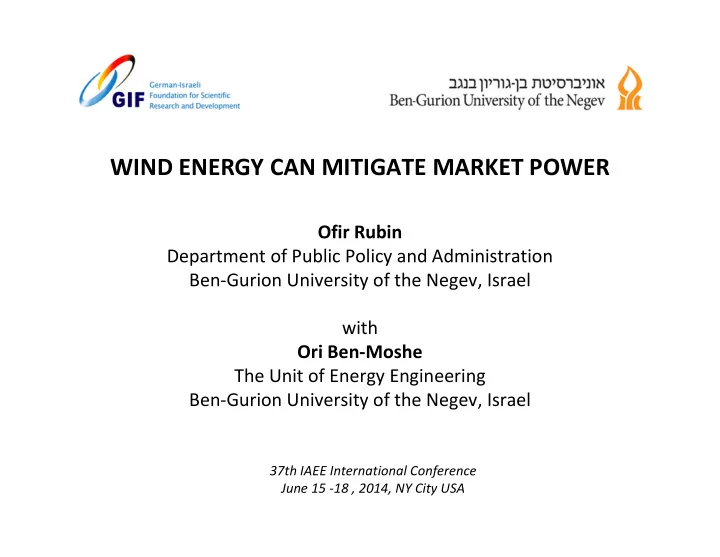

WIND ENERGY CAN MITIGATE MARKET POWER Ofir Rubin Department of Public Policy and Administration Ben-Gurion University of the Negev, Israel with Ori Ben-Moshe The Unit of Energy Engineering Ben-Gurion University of the Negev, Israel 37th IAEE International Conference June 15 -18 , 2014, NY City USA
Overview There is a large and ever growing body of literature indicating that as wind energy penetration rate increases electricity prices fall - Olsina et al. 2007 (Germany); Green & Vasilakos 2010 (GB) ; Traber & Kemfert 2011 (Germany); Woo et al. 2011 (Texas); Moreno, Lopez & Garcia-Alvarez 2012 (EU); Nielsen, Sorknaes & Ostergaard 2011 (Denmark); Pereira & Saraiva 2013 (Iberia); Bolino 2014 (Italy) In some cases prices may even become negative - Nicolosi 2010 (Germany); Brandstatt, Brunekreeft & Jahnke 2011 (Germany) 2
Overview Yet - – Twomey and Neuhoff (2010) showed that generators of conventional energy with market power can manipulate prices according to real-time conditions – Green & Vasilakos (2010) provided empirical support for this claim by showing that for a higher market concentration level, the revenues of conventional generators exceed those of wind power producers � It is unclear whether the observations are generalizable for any market structure and if not, what are the conditions of which wind energy has no dampening effect on electricity market prices? 3
Objective We seek to characterize analytically market conditions that give rise to the observed inverse relationship between wind penetration rate and electricity prices 4
Methodology We build on the model by Twomey & Neuhoff (2010) and suggest two additions. The original model: 1.Investigates the linkage between wind energy and market prices in a monopoly, duopoly and competitive market regimes 2.Assumes that the ownership of wind power capacity is introduced to the market only by price-taker firms We expand this framework in two ways: 1.We consider the case of oligopoly market, which in many cases may be more relevant 2.We allow a degree of freedom in the ownership type of wind power capacity. That is, in our model the strategic conventional generators firms are not prevented from owning and operating wind farms 5
Model Setup A short run model, treats one delivery period at a time • Energy is supplied only by conventional and wind energy units • M Symmetric Cournot type generator firms (GFs) • Wind supply is uncertain • γ is the share of wind power owned by GFs • Marginal generation cost of wind energy is zero • Trading mechanism: uniform price auction • Endogenous or exogenous number of forward contrasts • Focus on residual demand 6
Simulation Setup • Wind energy is uniformly distributed , and accounts up to 30% of expected load • Cost parameters are calibrated with respect to the original paper by Twomey & Neuhoff (2010) • Forward contracts amounts to 90% of expected load 7
Market power and electricity prices 8
Proposition 1 The average production level of strategic conventional generators decreases with the share of wind energy capacity owned by them 9
Proposition 1 : Numerical example Average GFs' output as a function of average wind energy output and wind ownership percentage by conventional GFs 10
Proposition 2 The impact of wind penetration rate on market prices depends on the share of wind energy capacity owned by strategic GFs 11
Proposition 2: Numerical example Price increases with more wind Price decreases with more wind Average market price as a function of average wind energy output and wind ownership percentage by conventional GFs 12
Proposition 3: The ratio between the average price of wind energy and the average market price increases with the share of wind energy owned by strategic GFs 13
Proposition 3: Numerical example Ratio between wind energy price and average market price, average wind energy output and percentage of wind capacity owned by GFs 14
Conclusions Our theoretical framework facilitates greater flexibility in modelling • the electric industry structure The analytical results, followed by numerical examples, indicate • that it is not always that wind energy brings electricity prices down Prices are likely to decrease when the number of firms is large • enough, the ownership of wind energy is sufficiently diversified or often a combination of the two Generators’ ownership of both conventional and renewable energy • may delay or, even to some extent, to exploit the availability of wind power to maximize their profits 15
Thank you! 16
More recommend